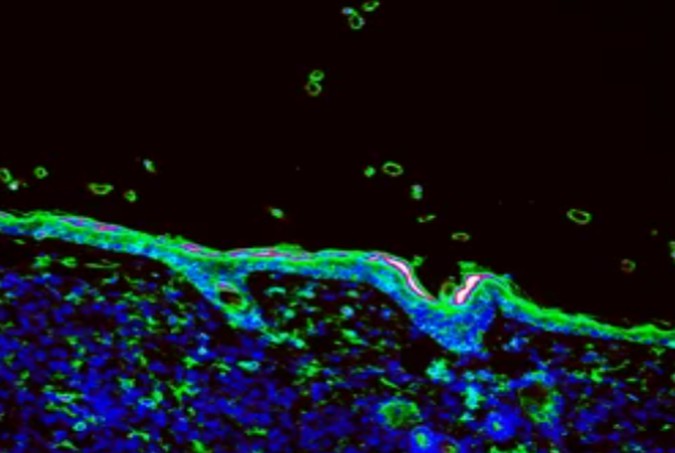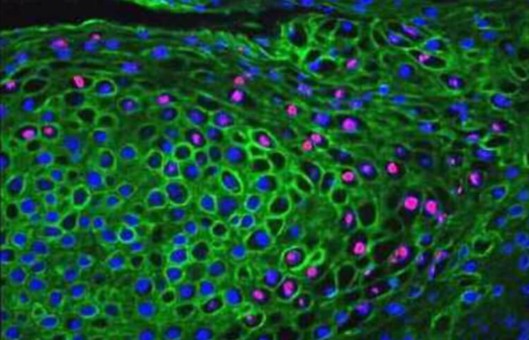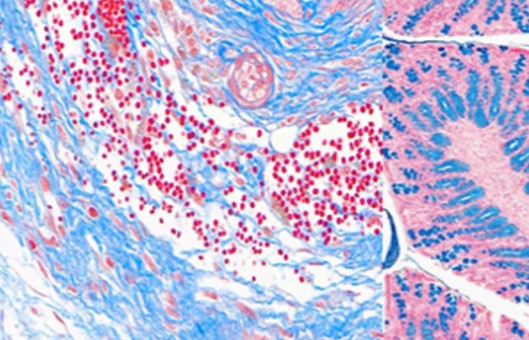IHC Protocol of SABC and SV Methods
GUIDELINE
The Strept Avidin-Biotin Complex (SABC) method is a simple and sensitive immunohistochemical method for displaying antigen distribution in tissues and cells. The SV (Super Vision) two-step method uses a polymerization labeling method to link peroxidase with secondary antibodies to form a super-sized antibody-enzyme polymer, replacing secondary and tertiary antibodies in the traditional method. This polymer possesses a powerful signal amplification ability and also has a strong tissue cell penetration. It has been tested to be more sensitive than similar products, especially against nuclear antigens, and its permeability is particularly strong for immunohistochemical applications.
METHODS
SABC Method
- Dewaxing of slices to water.
- Fresh configuration of 3% H2O2 at room temperature for 10 minutes to inactivate endogenous enzymes, followed by rinsing with distilled water for 2 minutes three times.
- Microwave repair. Place the slices in a cup containing PBS buffer (PH 7.2-7.6), heat and boil in a microwave oven, let stand in the microwave for 5 minutes, take out and cool at room temperature for 6 minutes, then microwave renewed heat to boiling and cool completely at room temperature.
- Add 5% BSA closure solution dropwise and react at 37°C for 30 minutes. Shake off excess liquid without washing.
- Add primary antibody dropwise and react overnight at 4°C. The concentration of the primary antibody prepared is 1 µg/ml.
- Wash in PBS buffer (pH 7.2-7.6) for 10 min x 3 times, add biotinylated secondary antibody IgG (anti-rabbit or anti-mouse) dropwise and react at 37°C for 30 min.
- Wash in PBS buffer (pH 7.2-7.6) for 10 min x 3 times, dropwise addition of reagent SABC, 30 min reaction at 37°C, 30 min PBS wash x 3 times.
- Color development of DAB at room temperature, control reaction time under the microscope, then wash with distilled water
- Add hematoxylin dropwise for 60 seconds for light re-staining, wash with distilled water and then immerse in saturated Na2HPO4 solution for 2 minutes, remove and wash, dry overnight at 37°C thermostat and seal the film with neutral gum.

SV Method
- The first 5 steps are the same as the SABC method.
- Wash with PBS buffer (pH 7.2-7.6) for 10 min x 3 times, add HRP-labeled secondary antibody IgG (anti-rabbit or anti-mouse) dropwise for 30 min at 37°C and wash with PBS buffer (pH 7.2-7.6) for 30 min x 3 times.
- The last 2 steps are also the same as the SABC method.
NOTES
- The process of dewaxing should be done in a fume hood at room temperature in summer. When the temperature is lower than 18°C, it is recommended to dewax at 50°C.
- If the staining background is too high, wash the section 4X with 0.01-0.02% TWEEN 20 PBS and 2X with pure PBS after the SABC reaction and before DAB staining. Then use DAB to stain the samples.
RELATED PRODUCTS & SERVICES
For research use only. Not for any other purpose.
Resources
- FAQ
- Protocol
- Cell Culture Guide
- Technical Bulletins
-
Explore & Learn
-
Cell Biology
- How to Handle Mycoplasma in Cell Culture?
- Strategies for Enrichment of Circulating Tumor Cells (CTCs)
- Enrichment, Isolation and Characterization of Circulating Tumor Cells (CTCs)
- Tips For Cell Cryopreservation
- How to Assess the Migratory and Invasive Capacity of Cells?
- What Cell Lines Are Commonly Used in Biopharmaceutical Production?
- STR Profiling—The ID Card of Cell Line
- Comparison of Several Techniques for the Detection of Apoptotic Cells
- What are the Differences Between M1 and M2 Macrophages?
- Mesenchymal Stem Cells: A Comprehensive Exploration
- Organoid Differentiation from Induced Pluripotent Stem Cells
- Quantification of Cytokines
- Multi-Differentiation of Peripheral Blood Mononuclear Cells
- Biomarkers and Signaling Pathways in Tumor Stem Cells
- IL-12 Family Cytokines and Their Immune Functions
- What are Mesothelial Cells?
- How to Scale Up Single-Cell Clones?
- Techniques for Cell Separation
- Contamination of Cell Cultures & Treatment
- Cell Culture Medium
- What Are Myeloid Cell Markers?
- Cryopreservation of Cells Step by Step
- Cell Cryopreservation Techniques and Practices
- Human Primary Cells: Definition, Assay, Applications
- How to Eliminate Mycoplasma From Cell Cultures?
- T Cell, NK Cell Differentiation from Induced Pluripotent Stem Cells
- Critical Quality Attributes and Assays for Induced Pluripotent Stem Cells
- What Is Cell Proliferation and How to Analyze It?
- Direct vs. Indirect Cell-Based ELISA
- Major Problems Caused by the Use of Uncharacterized Cell Lines
- Unveiling the Molecular Secrets of Adipogenesis in MSCs
- Tumor Stem Cells: Identification, Isolation and Therapeutic Interventions
- How to Decide Between 2D and 3D Cell Cultures?
- Isolation, Expansion, and Analysis of Natural Killer Cells
- Neural Differentiation from Induced Pluripotent Stem Cells
- Guidelines for Cell Banking to Ensure the Safety of Biologics
- Monocytes vs. Macrophages
- How to Detect and Remove Endotoxins in Biologics?
- Comparison of Different Methods to Measure Cell Viability
- What are PBMCs?
- How to Start Your Culture: Thawing Frozen Cells
- Circulating Tumor Cells as Cancer Biomarkers in the Clinic
- CFU Assay for Hematopoietic Cell
- Troubleshooting Cell Culture Contamination: A Comprehensive Guide
- CHO Cell Line Development
- How to Isolate PBMCs from Whole Blood?
- How to Isolate and Analyze Tumor-Infiltrating Leukocytes?
- Generation and Applications of Neural Stem Cells
- Stem Cell Markers
- Comparison of the MSCs from Different Sources
- T Cell Activation and Expansion
- Spheroid vs. Organoid: Choosing the Right 3D Model for Your Research
- Key Techniques in Primary, Immortalized and Stable Cell Line Development
- Cell-Based High-Throughput Screening Techniques
- Overview of Cell Apoptosis Assays
- Mastering Cell Culture and Cryopreservation: Key Strategies for Optimal Cell Viability and Stability
- Adherent and Suspension Cell Culture
- How to Maximize Efficiency in Cell-Based High-Throughput Screening?
- Understanding Immunogenicity Assays: A Comprehensive Guide
- What are White Blood Cells?
- What Are the Pros and Cons of Adoptive Cell Therapy?
- Role of Cell-Based Assays in Drug Discovery and Development
- Eosinophils vs. Basophils vs. Neutrophils
- Cultivated Meat: What to Know?
- Optimization Strategies of Cell-Based Assays
- 3D-Cell Model in Cell-Based Assay
- Immunogenicity Testing: ELISA and MSD Assays
- Optimization Strategies of Cell-Based Assays
- Immunogenicity Testing: ELISA and MSD Assays
- From Collection to Cure: How ACT Works in Cancer Immunotherapy
- Types of Cell Therapy for Cancer
- From Blur to Clarity: Solving Resolution Limits in Live Cell Imaging
- Live Cell Imaging: Unveiling the Dynamic World of Cellular Processes
- From Blur to Clarity: Solving Resolution Limits in Live Cell Imaging
- 3D-Cell Model in Cell-Based Assay
- Exploring Cell Dynamics: Migration, Invasion, Adhesion, Angiogenesis, and EMT Assays
- From Primary to Immortalized: Navigating Key Cell Lines in Biomedical Research
- A Complete Guide to Immortalized Cancer Cell Lines in Cancer Research
- Cell Viability, Proliferation and Cytotoxicity Assays
- What Are CAR T Cells?
- Cell Immortalization Step by Step
- Live Cell Imaging: Unveiling the Dynamic World of Cellular Processes
-
Histology
- Multiple Animal Tissue Arrays
- Troubleshooting in Fluorescent Staining
- Fluorescent Nuclear Staining Dyes
- Tips for Choosing the Right Protease Inhibitor
- Guides for Live Cell Imaging Dyes
- Instructions for Tumour Tissue Collection, Storage and Dissociation
- Cell Lysates: Composition, Properties, and Preparation
- Overview of the FFPE Cell Pellet Product Lines
- Immunohistochemistry Troubleshooting
- Cell and Tissue Fixation
- Microscope Platforms
- How to Apply NGS Technologies to FFPE Tissues?
- Overview of Common Tracking Labels for MSCs
- Mitochondrial Staining
- Immunohistochemistry Controls
- Comparison of Membrane Stains vs. Cell Surface Stains
- Stains Used in Histology
- How to Choose the Right Antibody for Immunohistochemistry (IHC)
- How to Begin with Multiplex Immunohistochemistry (mIHC)
- Common Immunohistochemistry Stains and Their Role in Cancer Diagnosis
- How Immunohistochemistry Makes the Invisible Brain Visible?
- Histological Staining Techniques: From Traditional Chemical Staining to Immunohistochemistry
- Serum vs. Plasma
- Comparing IHC, ICC, and IF: Which One Fits Your Research?
- Multiplexing Immunohistochemistry
- What You Must Know About Neuroscience IHC?
- Modern Histological Techniques
- From Specimen to Slide: Core Methods in Histological Practice
-
Exosome
- What's the Potential of PELN in Disease Treatment?
- How to Enhancement Exosome Production?
- How to characterize exosomes?
- How to Efficiently Utilize MSC Exosomes for Disease Treatment?
- Emerging Technologies and Methodologies for Exosome Research
- Summary of Approaches for Loading Cargo into Exosomes
- How to Label Exosomes?
- Exosomes as Emerging Biomarker Tools for Diseases
- How to Apply Exosomes in Clinical?
- Classification, Isolation Techniques and Characterization of Exosomes
- How to Perform Targeted Modification of Exosomes?
- How do PELN Deliver Drugs?
- Current Research Status of Milk Exosomes
- Exosome Quality Control: How to Do It?
- The Role of Exosomes in Cancer
- Techniques for Exosome Quantification
- What are the Functions of Exosomal Proteins?
- Exosome Size Measurement
- Applications of MSC-EVs in Immune Regulation and Regeneration
- Production of Exosomes: Human Cell Lines and Cultivation Modes
- Unraveling Biogenesis and Composition of Exosomes
- Common Techniques for Exosome Nucleic Acid Extraction
- Exosome Transfection for Altering Biomolecular Delivery
- How Important are Lipids in Exosome Composition and Biogenesis?
- Exosome Antibodies
- Collection of Exosome Samples and Precautions
-
ISH/FISH
- ISH probe labeling method
- Reagents Used in FISH Experiments
- What Types of Multicolor FISH Probe Sets Are Available?
- Mapping of Transgenes by FISH
- Telomere Length Measurement Methods
- Comprehensive Comparison of IHC, CISH, and FISH Techniques
- FISH Techniques for Biofilm Detection
- Whole Chromosome Painting Probes for FISH
- Multiple Options for Proving Monoclonality
- What Is the Use of FISH in Solid Tumors?
- Small RNA Detection by ISH Methods
- What are the Differences between FISH, aCGH, and NGS?
- FISH Tips and Troubleshooting
- Differences Between DNA and RNA Probes
- Overview of Oligo-FISH Technology
- Comparative Genomic Hybridization and Its Applications
- In Situ Hybridization Probes
- Guidelines for the Design of FISH Probes
- Different Types of FISH Probes for Oncology Research
- How to Use FISH in Hematologic Neoplasms?
- What are Single, Dual, and Multiplex ISH?
- Overview of Common FISH Techniques
- Multiple Approaches to Karyotyping
- RNAscope ISH Technology
- CARD-FISH: Illuminating Microbial Diversity
- ImmunoFISH: Integrates FISH and IL for Dual Detection
- 9 ISH Tips You Can't Ignore
-
Toxicokinetics & Pharmacokinetics
- Key Considerations in Toxicokinetic
- Organ-on-a-Chip Systems for Drug Screening
- Experimental Methods for Identifying Drug-Drug Interactions
- How to Improve Drug Plasma Stability?
- What Are Metabolism-Mediated Drug-Drug Interactions?
- Traditional vs. Novel Drug Delivery Methods
- Pharmacokinetics Considerations for Antibody Drug Conjugates
- Overview of In Vitro Permeability Assays
- Methods of Parallel Artificial Membrane Permeability Assays
- The Rise of In Vitro Testing in Drug Development
- How to Conduct a Bioavailability Assessment?
- Predictive Modeling of Metabolic Drug Toxicity
- What Are Compartment Models in Pharmacokinetics?
- Comparison of MDCK-MDR1 and Caco-2 Cell-Based Permeability Assays
- Unraveling the Role of hERG Channels in Drug Safety
- What factors influence drug distribution?
- How to Design and Synthesize Antibody Drug Conjugates?
- Key Factors Influencing Brain Distribution of Drugs
- Physical and Chemical Properties of Drugs and Calculations
- What Is the Role of the Blood-Brain Barrier in Drug Delivery?
- Parameters of Pharmacokinetics: Absorption, Distribution, Metabolism, Excretion
- What are the Pharmacokinetic Properties of the Antisense Oligonucleotides?
- How to Improve Drug Distribution in the Brain
- Effects of Cytochrome P450 Metabolism on Drug Interactions
- Toxicokinetics vs. Pharmacokinetics
- Pharmacokinetics of Therapeutic Peptides
- How Is the Cytotoxicity of Drugs Determined?
- How to Improve the Pharmacokinetic Properties of Peptides?
- Organoids in Drug Discovery: Revolutionizing Therapeutic Research
- What Are the Best Methods to Test Cardiotoxicity?
- Why Cardiotoxicity Matters in R&D?
-
Disease Models
- What Human Disease Models Are Available for Drug Development?
- Overview of Cardiovascular Disease Models in Drug Discovery
- Summary of Advantages and Limitations of Different Oncology Animal Models
- Why Use PDX Models for Cancer Research?
- Disease Models of Diabetes Mellitus
- Animal Models of Neurodegenerative Diseases
- Preclinical Models of Acute Liver Failure
-
Cell Biology
- Life Science Articles
- Download Center
- Trending Newsletter

